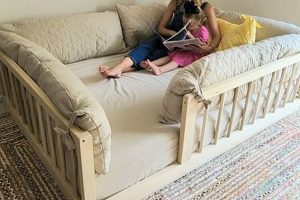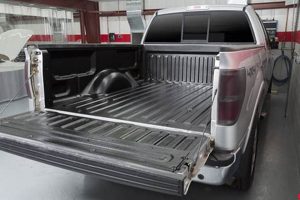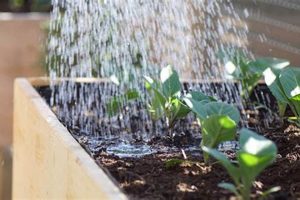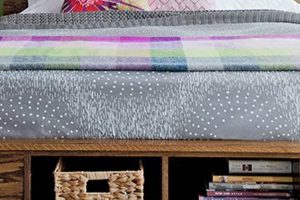A child’s sleeping arrangement situated directly on the floor, often constructed by caregivers, provides easy access for young children. This arrangement generally involves a mattress placed without an elevated frame, promoting independence and freedom of movement. For example, a family might choose this type of setup to foster a toddler’s autonomy in getting in and out of bed.
This type of low-to-the-ground bed offers several advantages, including increased safety by eliminating the risk of falls from a height. Historically, similar sleeping arrangements have been common in various cultures, often reflecting a focus on child-led development and accessible environments. These beds can also facilitate easier parental interaction and comfort during the night.
The subsequent sections will address considerations for building a safe and functional sleeping space, exploring design options, material choices, and crucial safety guidelines to ensure a secure environment for the child. Careful planning and execution are vital for a successful project.
Construction Advice
The following recommendations are intended to assist in the creation of a secure and functional sleeping space for a young child.
Tip 1: Mattress Selection: Opt for a firm mattress appropriate for toddler use. A firm surface reduces the risk of suffocation and ensures adequate support for the child’s developing spine. Crib mattresses often meet these criteria.
Tip 2: Frame Alternatives: If constructing a frame, prioritize rounded edges and smooth surfaces. Avoid sharp corners or protruding hardware that could pose a safety hazard. Consider simple, low-profile designs.
Tip 3: Material Safety: Use non-toxic materials throughout the construction process. Ensure that any paint, varnish, or sealant used is specifically labeled as safe for children and free of volatile organic compounds (VOCs).
Tip 4: Regular Inspection: Periodically inspect the structure for any signs of damage or wear. Tighten any loose screws or bolts and address any splinters or rough edges promptly to maintain a safe environment.
Tip 5: Room Arrangement: Ensure that the area surrounding the bed is free of clutter and potential hazards. Remove any sharp objects, unstable furniture, or electrical cords that could pose a risk to the child.
Tip 6: Breathable Bedding: Use breathable bedding materials, such as cotton or muslin. Avoid heavy blankets, comforters, or pillows that could restrict movement or pose a suffocation risk.
Tip 7: Gradual Transition: When introducing the sleeping space, allow the child time to adjust. Familiarize the child with the area during daylight hours and create a positive association with the new sleeping arrangement.
These guidelines aim to foster a secure and supportive environment for the child during sleep. Prioritizing safety in construction and use is paramount.
The article will now transition to explore the advantages and potential challenges associated with this type of sleeping arrangement.
1. Safety
Safety is paramount in the context of a child’s sleeping environment. A “diy toddler floor bed,” while promoting independence and accessibility, requires careful consideration of safety protocols to mitigate potential risks.
- Mattress Selection and Support
The choice of mattress directly impacts safety. A firm mattress designed for infant or toddler use is essential. This firmness reduces the risk of suffocation and provides adequate support for the child’s developing musculoskeletal system. Additionally, the absence of gaps between the mattress and any surrounding frame is critical to prevent entrapment.
- Material Toxicity and Environmental Factors
Materials used in the construction of a “diy toddler floor bed” must be non-toxic. Paints, finishes, and adhesives should be specifically formulated for children’s products, minimizing exposure to harmful chemicals. Furthermore, the surrounding environment should be free of hazards such as electrical cords, sharp objects, and unstable furniture that could pose a risk to the child.
- Fall Prevention and Room Arrangement
While the low profile of a floor bed inherently reduces the risk of falls from a height, the surrounding area should still be carefully arranged. Soft, padded surfaces can be placed around the bed to cushion any accidental tumbles. Furthermore, potential obstacles should be removed to provide a clear and safe path for the child to navigate during the night.
- Regular Inspection and Maintenance
Ongoing maintenance is essential for ensuring the continued safety of the sleeping arrangement. Regular inspections should be conducted to identify any signs of wear or damage, such as loose screws, splinters, or tears in the mattress cover. Prompt repairs are crucial to prevent potential injuries.
These multifaceted considerations highlight the integral role of safety protocols in the construction and utilization of this sleeping arrangement. Vigilance and proactive measures are essential to create a secure environment that supports the child’s development and well-being, ultimately determining the arrangement’s suitability.
2. Accessibility
Accessibility is a defining characteristic of a sleeping arrangement. Its low profile allows toddlers to enter and exit the bed independently, fostering a sense of autonomy and self-reliance. This contrasts with traditional cribs or raised beds, which often require parental assistance, potentially hindering the development of independent movement. The ease of access minimizes the risk of falls associated with climbing over obstacles. For example, a toddler awakening during the night can safely leave the bed to seek parental comfort or use the restroom, reducing potential distress and promoting confidence.
The accessibility of this bed can also influence parental responsiveness. Parents can easily sit or lie down beside the child, facilitating comfort and reassurance during bedtime routines or nighttime awakenings. This close proximity can be particularly beneficial during periods of illness or emotional distress, allowing for immediate parental intervention and support. Furthermore, the bed’s design promotes a less restrictive environment, enabling the child to freely explore their surroundings upon waking, encouraging exploration and learning within a safe and controlled space.
However, the benefits of accessibility require careful consideration of safety. While the ease of movement is advantageous, it also necessitates vigilance on the part of caregivers. Ensuring that the surrounding area is free of hazards and that appropriate safety measures are in place is crucial. The accessibility inherent in this design empowers the child, but responsible oversight remains paramount, requiring a balance between fostering independence and maintaining a secure environment.
3. Independence
A sleeping arrangement supports a toddler’s developing sense of independence by granting unrestrained access and egress. Unlike conventional cribs that confine movement, a floor bed allows a child to freely explore their environment upon waking, fostering self-reliance. This autonomy supports the development of decision-making skills and contributes to a sense of personal agency. For example, a toddler can choose to play quietly with toys near the bed or seek out a caregiver, rather than being constrained and reliant on external assistance. This promotes confidence and reduces frustration associated with confinement.
The element of independent mobility can directly impact a child’s developmental trajectory. By allowing toddlers to navigate their surroundings without physical barriers, the sleeping arrangement facilitates exploration and learning. This setup empowers children to regulate their own bedtime routines, potentially leading to more positive sleep associations. The ability to independently get out of bed can also reduce reliance on parental intervention during nighttime awakenings, improving sleep quality for both the child and caregivers. The fostering of such self-sufficiency through design choices presents a tangible benefit.
However, granting independence necessitates responsible implementation. A safe and carefully prepared environment is essential to prevent potential hazards. While promoting autonomy, caregivers must maintain vigilance to ensure the child’s well-being. The goal is to strike a balance between fostering self-reliance and providing necessary support. This sleeping arrangement, when thoughtfully implemented, serves as a valuable tool in nurturing a child’s developing sense of independence, but necessitates comprehensive safety measures and parental attentiveness.
4. Materials
Material selection is a critical determinant of the safety, durability, and overall suitability of a constructed sleeping arrangement. The choices made regarding materials significantly influence the physical environment experienced by the child.
- Wood Selection and Treatment
The type of wood employed in the construction process directly impacts structural integrity and potential toxicity. Solid wood, such as pine or maple, offers durability, while engineered wood products require scrutiny for formaldehyde emissions. Treatments, including paints and sealants, necessitate careful selection to ensure they are non-toxic and appropriate for children’s products. Any applied finish must adhere to safety standards, mitigating the risk of ingestion or inhalation of harmful chemicals.
- Fasteners and Hardware
The selection of fasteners, such as screws and bolts, is crucial for the structural stability of the bed. These components must be appropriately sized and securely fastened to prevent loosening or detachment, which could present a safety hazard. Metallic hardware should be corrosion-resistant to ensure longevity and prevent the release of potentially harmful substances. Recessed or covered fasteners minimize the risk of injury.
- Mattress Composition and Certification
The mattress core and cover materials significantly impact comfort and potential allergen exposure. Foam mattresses should be certified as low-VOC (volatile organic compound) emitting, while natural materials like cotton or wool offer hypoallergenic properties. The mattress cover should be breathable and washable, facilitating hygiene and preventing moisture accumulation. Certification labels, such as Greenguard Gold, provide assurance of adherence to emissions standards.
- Textiles and Bedding
Bedding materials, including sheets, blankets, and mattress protectors, necessitate careful consideration of fiber content and manufacturing processes. Natural fibers, such as organic cotton or linen, are preferable due to their breathability and reduced chemical exposure. Dyes and finishes should be non-toxic and hypoallergenic, minimizing the risk of skin irritation or allergic reactions. Regular laundering of bedding is essential to maintain hygiene and prevent the accumulation of allergens.
The conscious selection and responsible application of materials are fundamental to ensuring the safety, longevity, and overall suitability of a constructed sleeping space. Prioritizing non-toxic, durable, and appropriately certified materials is paramount for safeguarding the child’s well-being and maximizing the utility of the design.
5. Dimensions
Dimensional considerations are critical to the functionality and safety of a constructed sleeping space. Size dictates the accommodation of the child’s physical growth, while space constraints within the room necessitate careful planning. Improper dimensions can compromise safety by creating hazards such as entrapment risks or instability. For instance, a mattress that is too small for the frame could create gaps, while an excessively large structure could overwhelm the room, impeding movement and increasing the potential for collisions. Precise dimensional planning ensures a harmonious balance between the child’s needs and the spatial limitations of the environment.
Determining appropriate dimensions necessitates consideration of several factors, including the child’s age, size, and developmental stage. The sleeping surface must be large enough to permit comfortable movement and prevent accidental roll-out. Furthermore, the height of the structure, if any, should be low enough to minimize the risk of falls. A practical example includes adapting standard crib mattress dimensions for the floor bed to ensure compatibility and readily available bedding. Adherence to these principles contributes to a safe and ergonomically sound design that supports the child’s physical comfort and well-being.
In summary, dimensional precision is an indispensable element in the construction of a safe and functional sleeping arrangement. Meticulous planning, informed by a thorough understanding of the child’s needs and the spatial constraints of the environment, mitigates potential risks and maximizes the utility of the design. Challenges arise primarily from balancing safety requirements with the desire for space efficiency, highlighting the need for careful measurements and thoughtful material selection. Prioritizing appropriate dimensions directly enhances safety and promotes a comfortable sleep environment for the child.
6. Construction
The physical creation of a sleeping arrangement directly influences its safety, stability, and suitability. Adherence to sound construction principles is paramount to ensure a secure and functional environment for the child. The structural integrity, material choices, and assembly techniques employed during construction profoundly impact the longevity and reliability of the finished product.
- Structural Design and Stability
The fundamental framework dictates the overall stability and weight-bearing capacity. A well-designed structure distributes weight evenly, preventing tipping or collapse. Reinforced joints and sturdy materials are critical components. For example, a simple platform constructed with adequately sized lumber and securely fastened joints provides a stable base for the mattress, minimizing the risk of structural failure.
- Material Cutting and Preparation
Precise cutting and preparation of materials are essential for accurate assembly and a professional finish. Clean, straight cuts minimize gaps and ensure flush connections. Sanding rough edges prevents splinters and improves the aesthetic appeal. For instance, accurately measuring and cutting wood components according to the planned dimensions results in a snug fit and a structurally sound bed frame.
- Assembly Techniques and Fasteners
The techniques employed for assembling the components, along with the selection of appropriate fasteners, significantly impact the structural integrity. Secure joinery methods, such as screws, bolts, or dowels, ensure a strong and lasting connection. Proper alignment and tightening of fasteners are crucial to prevent loosening or separation over time. Utilizing wood glue in conjunction with mechanical fasteners enhances the strength and durability of the joints.
- Finishing and Surface Treatment
The application of finishes and surface treatments serves both aesthetic and functional purposes. Protective coatings, such as paint or varnish, enhance durability and prevent moisture damage. Non-toxic finishes are essential for ensuring the child’s safety. A smooth, even finish eliminates sharp edges and creates a visually appealing and safe surface.
These construction aspects directly correlate with the ultimate effectiveness and safety of this sleeping arrangement. Prioritizing sound construction principles throughout the process ensures a durable, secure, and comfortable sleeping environment, underscoring the significance of meticulous planning and execution.
7. Supervision
A low-profile sleeping arrangement inherently expands a toddler’s accessible environment, thereby increasing the requirement for vigilant oversight. The design fosters independent exploration, which, in turn, demands that caregivers proactively manage the child’s surroundings to mitigate potential hazards. For example, a toddler, upon waking, can independently navigate the room, potentially encountering unsecured objects or unsafe areas without immediate parental awareness. Therefore, consistent monitoring is crucial to prevent accidents.
The effectiveness of this setup depends significantly on the capacity of caregivers to adapt their supervision strategies. Proactive measures, such as securing furniture, covering electrical outlets, and removing hazardous materials from the child’s reach, form the foundation of a safe environment. Furthermore, the implementation of visual or auditory monitoring systems can provide additional layers of security. Nighttime supervision, in particular, necessitates careful planning. Regular checks on the child’s well-being and immediate responsiveness to any signs of distress are essential.
In summary, the link between constant watchfulness and a this arrangement is inextricably linked. The design inherently fosters independence, yet this independence necessitates elevated levels of supervision. Successfully implementing this requires adapting supervision strategies, proactively managing environmental risks, and maintaining consistent attentiveness. Challenges arise from balancing a child’s autonomy with the need for safety, highlighting the continuous interplay between design and responsible parental oversight. Effective supervision is not merely an adjunct to the design but an integral element in ensuring a secure environment.
Frequently Asked Questions
The following addresses prevalent inquiries regarding construction and implementation of sleeping arrangements.
Question 1: What constitutes an appropriate mattress for this particular sleeping arrangement?
An appropriate mattress should be firm, designed for toddler use, and free of harmful chemicals. Crib mattresses often meet these requirements. Ensure the dimensions fit the intended frame, if one is used, with minimal gaps.
Question 2: How is safety maintained given the child’s increased mobility?
Safety is maintained through proactive measures, including securing furniture, covering electrical outlets, removing hazards from the child’s reach, and consistent monitoring, especially during nighttime hours.
Question 3: Are there specific materials to avoid in the construction process?
Materials containing volatile organic compounds (VOCs) and those treated with harmful chemicals should be avoided. Opt for non-toxic paints, finishes, and natural, untreated wood whenever possible.
Question 4: How often should the structure be inspected for safety?
Regular inspections are essential, ideally conducted weekly. Check for loose screws, splinters, or any signs of damage that could pose a risk to the child.
Question 5: Can this type of bed be implemented in a small room?
Implementation in a small room is feasible but requires careful planning. Maximize space by opting for a minimalist design and ensuring ample room for the child to move around safely.
Question 6: What is the recommended age range for transitioning to this type of sleeping arrangement?
The transition is typically appropriate when the child demonstrates the ability to safely climb in and out of a crib, often between 18 months and 3 years of age. Individual development should guide the decision.
In conclusion, successful implementation hinges on prioritizing safety, meticulous planning, and consistent supervision. Consideration of these factors is crucial for creating a secure sleeping environment.
The next section will discuss potential design considerations and customisation options.
Conclusion
This exploration of the construction and implementation of a sleeping arrangement has underscored crucial factors, from material selection and structural integrity to consistent supervision. Safety remains paramount throughout the decision-making and building phases. Successful employment hinges on a comprehensive understanding of potential hazards and a commitment to proactive mitigation strategies.
The decision to proceed with constructing this sleeping arrangement warrants careful consideration. The long-term safety and well-being of the child must remain the central focus. Ongoing vigilance, coupled with informed decision-making, is essential for realizing the potential benefits while minimizing inherent risks. Prioritize safety; only then can the promise of independent exploration be thoughtfully realized.







